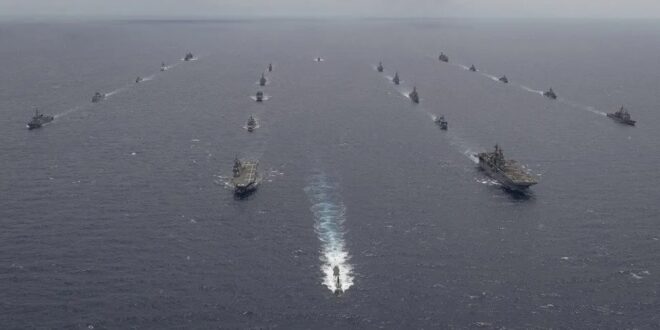As the Russo-Ukrainian war continues to rage on through its 100th day, things are getting frosty over with RIMPAC. Twenty-six countries headed by the United States will be conducting Exercise RIMPAC 2022 from June 29 to August 4 in what is the world’s biggest naval exercise to date.
It has been reported that the exercise will be composed of some 38 surface ships, four submarines, and 170 aircraft from all QUAD members, namely India, Japan, Australia, and the US, as well as five Southeast Asian nations that all have their scores to settle with China namely: the Philippines, Brunei, Singapore, Thailand, and Indonesia. They will also be joined by Tonga, a country that has been engaging with China. Nine land forces comprising 25,000 personnel will also be part of the drill.
Here is the complete list of all countries participating:
Australia
Brunei
Canada
Chile
Colombia
Denmark
Ecuador
France
Germany
India
Indonesia
Israel
Japan
Malaysia
Mexico
Netherlands
New Zealand
Peru
Republic of Korea
Republic of the Philippines
Singapore
Sri Lanka
Thailand
Tonga
the United Kingdom
the United StatesFirst held in 1971, today’s RIMPAC is important as a show of international solidarity as China continues to be aggressive in the region. With islands and areas continually being contested in the South China Sea, increased aggression against Taiwan in its pursuit to “reunify” it with the mainland, and a new security pact with the Solomon Islands, the exercise will primarily be about building stronger relationships and cooperation with allies in the Pacific, as well as around the world.
“As the world’s largest international maritime exercise, RIMPAC provides a unique training opportunity designed to foster and sustain cooperative relationships that are critical to ensuring the safety of sea lanes and security on the world’s interconnected oceans,” says the US 3rd Fleet.
But we all know that the exercises aren’t just about fostering good relations with our allies. It will also act as a stern warning to China, showing them that the US, along with its allies, is prepared to rise to the occasion if tensions escalate.
China has increasingly been annoyed and angered by the US presence in the region, arguably the only naval force that has the capacity to keep China at bay with its expansionism. It is noteworthy that both the QUAD (Australia, India, Japan, and the US) and AUKUS (Australia, the United Kingdom, and the United States) are part of the exercise as these groups are actively cooperating with one another to maintain regional stability in the Pacific, as well as to share resources and technology respectively.
China, who has been wary of the two groups, has repeatedly expressed its opposition to the groups, accusing the US of building an “Asian NATO” and engaging in Cold War-type tactics against China, describing the move as an “Anglo-Saxon clique.”
“Its (AUKUS’) ultimate goal is to build a NATO replica in the Asia-Pacific to serve the US hegemony and self-interests through and through. Asia-Pacific countries will resolutely say no to it for sure,” Chinese Foreign Ministry Spokesperson Zhao Lijian said.
The Philippines, one of the US’s oldest allies in the region, was quick to reject the claim, stating that the move was good to “restore and keep the balance, rather than destabilize it.”
“Proximity breeds brevity in response time, thereby enhancing an ASEAN near friend and ally’s military capacity to respond to a threat to the region or challenge the status quo,” he said. However, with the Philippines electing a largely pro-Chinese President in President-elect Ferdinand “Bongbong” Marcos Jr., the country’s foreign policy remains unknown. He has not explicitly stated pro-Chinese or pro-US sentiments, stating that he was a friend to all countries.
The Chinese were also concerned about AUKUS’s technology-sharing initiative to share information and development of hypersonic weapons to improve each other’s capability of launching such weapons.
Regardless of their concerns, the US-led exercise will push through and will take place around the Hawaiian Islands off the coast of Southern California, hosted by the US Pacific Fleet and the US 3rd Fleet as the Combined Task Force (CTF) Commander.
It’s important to note that the Chinese were once part of the biennial RIMPAC drills from 2014, 2016, and 2018, just that they were very aggressive in the Pacific, which led them to get not invited anymore.
The event will also be done in coordination with Royal Canadian Navy Rear Adm. Christopher Robinson, who will serve as deputy commander of the Combined Task Force, and Japan Maritime Self-Defense Force Rear Adm. Toshiyuki Hirata, who will serve as the vice commander. The Fleet Marine Force will be led by U.S. Marine Corps Brig. Gen. Joseph Clearfield. Other vital leaders of the exercises will also include Commodore Paul O’Grady of the Royal Australian Navy, who is in charge of the maritime component, and Brig. Gen. Mark Goulden of the Royal Canadian Air Force will be in charge of the air component.
 Eurasia Press & News
Eurasia Press & News



